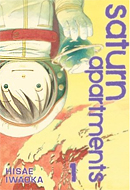   |
Manga-ka: Hisae Iwaoka
Publisher: Viz Media
Rating: Teen (13+)
Release Date: May 2010
Synopsis: “Far in the future, humankind has evacuated the Earth in order to preserve it. Humans now reside in a gigantic structure that forms a ring around the Earth, thirty–five kilometers up in the sky. The society of the Ring is highly stratified: the higher the floor, the greater the status. Mitsu, the lowly son of a window washer, has just graduated junior high. When his father disappears and is assumed dead, Mitsu must take on his father’s occupation. As he struggles with the transition to working life, Mitsu’s job treats him to an outsider’s view into the various living–room dioramas of the Saturn Apartments.”
There are a lot of interesting elements in Saturn Apartments. The science is solid and thought-out, and the hierarchy of Saturn Apartments makes for interesting social commentary. But, while these elements are always present, the real focus is on the human stories of the individuals window-washing Mitsu meets on the job. Still, though the characters are cute and their stories tug at the heartstrings, personally I was more interested in the world than the people who populated it.
Mitsu has just graduated from school (it’s not clear if he just completed high school or college or what. From how young his character design looks, it could even be elementary school). Mitsu plans to follow in his father’s footsteps and become a window washer. Window washing on Saturn Apartments is no easy job. It involves donning a space suit and going on the outside of the space station. Accidents happen, and sometimes people die on the job. Mitsu knows this better than anyone: years ago his father’s rope broke and he fell down to earth.
Mitsu has some questions about his father’s death, and as he gets to know his co-workers he begins to fill in the blanks, not only about how his father died, but also how he lived. Mitsu’s job brings him into contact with many different people from all walks of life: a poor couple who want a clean window for their wedding, a marine biologist who wants his window to look like the ocean and a scientist who is trying to make window washing robots. Mitsu also gets to know his co-workers and learns they each have stories of their own.
The stories are mostly episodic, but at the same time each story builds on the characters and the world they inhabit. My favourite parts of the book are when the stories focusing on Mitsu’s co-workers. They worked not only as stand-alone stories but also seemed to be setting the scene for future volumes.
The stories work and the characters feel like real people, but its the hints at the world’s background that really made me interested. While Saturn Apartments is not exactly ‘hard’ science fiction (sci-fi that focuses on the scientific aspects of the story) it’s still pretty clear that the manga-ka has done her homework. There are all kinds of little tidbits that get dropped casually (and naturally) into the story. For example, we get to see how not getting enough natural light affects the human body (window washers have better immune systems than most thanks to their exposure to sunlight). There’s also a scene where the washers have to spend seven hours in a decompression chamber just to get used to the upper level’s air pressure. It’s the inclusion of these things that make Saturn Apartments work as an entertaining science fiction story.
Another interesting aspect of the story is the social structure of Saturn Apartments. There’s no mention of a government or who’s in charge. It seems to be a private enterprise, a plutocracy where the rich can live in big, spacious apartments filled with natural sunlight while the lower class live in dark slums, families crowded into one room homes. Movement between the levels is highly restricted. It’s interesting to see Mitsu’s blue-collar co-workers interact with the rich people who hire them. It makes me wish the manga took it further. The manga sets up a system that is ripe for exploring classism, but instead of tackling the issue it puts it aside for something more sweet and sentimental. I really hope that in future volumes the tension that lurks beneath the surface of Saturn Apartments comes to the top.
The art is strange, in that it works for the sentimental nature of the plot but works against the realistic, scientifically grounded setting. The people are all very cute and childlike. They have big heads, small features, rounded faces, short limbs and thick bodies. Basically, they look like big babies. The art uses a lot of thin lines, giving the artwork a sketchy but assured style. It takes a little while to get used to seeing something as complicated and advanced as a huge space station drawn in this simple style, but after a while you get used to it.
While reading Saturn Apartments, I couldn’t help but be reminded of one of my favourite manga, Planetes. Planetes is very similar to Saturn Apartments in that it features a group of people living in space doing a mundane job (in Planetes its collecting garbage, here it’s washing windows). Both mix character development with hard sci-fi. But every time I compared them, it was Planetes that came out ahead. This is largely just personal preference: I prefer the detailed, realistic art of Plantes as I feel it reflects the detailed, realistic feel of the story. Likewise, I’m sure there will be people who prefer Saturn Apartment’s simpler art and laid-back atmosphere. Plus, this is only the first volume. My hope is that as the series continues its themes will grow stronger and step out from the background, as the hints in volume one makes me eager for more.
Review written June 25, 2010 by Shannon Fay
Book purchased at Anime North


 Follow
Follow
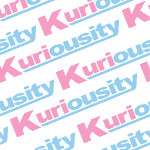
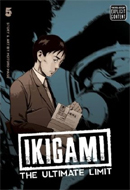





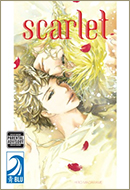








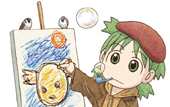









I believe Mitsu graduated from middle school. I got a pretty strong impression of that.
I also found the world interesting. Mostly, I want to know how they came to build and live on the ring, what the surface of the planet is like, how long they'll have to live in the atmosphere, etc. The attention to detail is great, though I didn't take too much notice of it personally – like, as you mentioned, the characters camping out in decompression chambers for 7 hours before going out to work.
The social structure is what really got me; that's fascinating stuff. That one story was so sad, about the couple who wanted to work in the middle or upper levels, and were working toward that goal, only to be told it was useless to even bother.
You listed Vertical as the publisher even though it links to Viz's site. It is part of the Viz Signature Ikki line.
Chapters can be read here:
http://www.sigikki.com/series/saturnapartments/in…
Saturn Apartments, Children of the Sea and Not Simple are my favorite manga from the Ikki line.
Middle-school does seem to fit with how young Mitsu looks, though the talk about repaying student loans threw me off (but making people pay for freakin' middle school seems to fit with the privatized, corporate world the manga seems to be set in).
Thanks for catching the mis-named link Danish. I'm really liking the sigikki site, especially 'House of Five Leaves.'
[…] (The Comic Book Bin) Michelle Smith on vols. 1-3 of Saiyuki (Soliloquy in Blue) Shannon Fay on vol. 1 of Saturn Apartments (Kuriousity) Connie on vol. 8 of Slam Dunk (Slightly Biased Manga) Connie on vol. 2 of Song of the […]